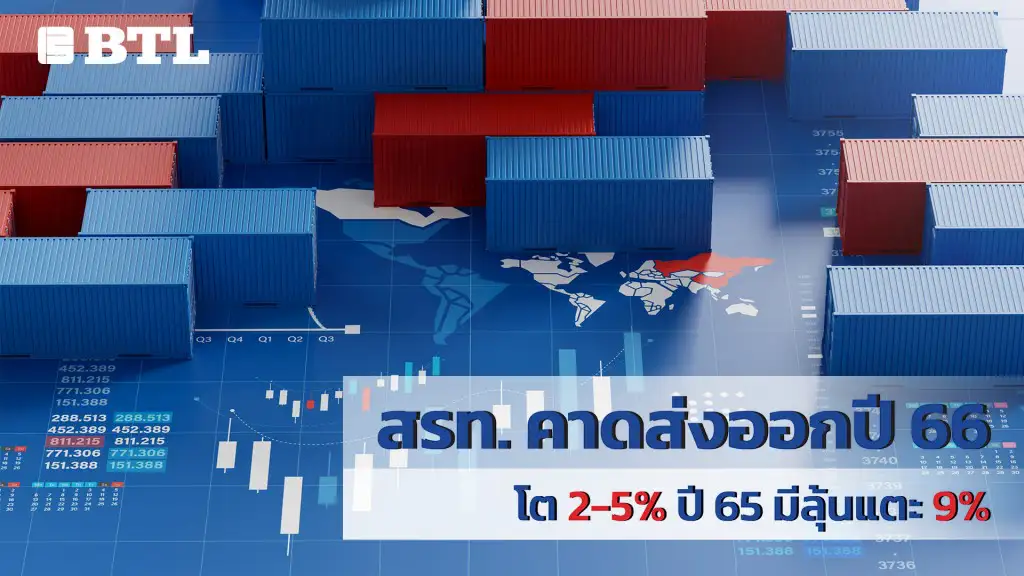



The Thai National Shippers' Council (TNSC) or the Exporters' Council predicts that Thai exports in 2023 will grow by 2-5%.
Mr. Chaichan Charoensuk, Chairman of the Thai National Shippers’ Council (TNSC) or the Exporters’ Council, predicted that Thai exports in 2023 will grow by 2-5%, with the main factors being the need to monitor the global economic contraction next year, which is expected to be no greater than in Q4/2022, monitoring the weakening of the baht, which is expected to weaken to a medium level of around 36-38 baht/US dollar, and higher costs from oil prices, electricity costs, and wages.
However, oil prices are expected to decline, expected to be at $90/barrel, while freight rates are also likely to decline on main routes. As for the problem of raw material prices fluctuating, even though the semiconductor problem has eased somewhat, it is still necessary to closely monitor.
While for the whole of 2022, exports are expected to grow by 8% and have the opportunity to reach 9% if exports in the fourth quarter of this year continue to grow and are not impacted further than this. However, if exports are to reach 10%, it will require more economic and export growth, which is considered moderate to low.
For the important supporting factors of 2022 are:
1. The baht continues to move in a depreciating direction, which has an impact on Thai exports of products that use domestic raw materials (Local Content), especially exports to the United States and the Middle East.
2. The global food crisis has resulted in an increase in Thai chicken products (chilled, frozen and processed) and canned food exports to the European Union and the United Kingdom, as well as rice products.
But there are still risk factors that are significant obstacles in 2022, including:
1. The inflation rate situation of major trading partners has a tendency to increase continuously, especially the United States. As a result, the US Federal Reserve (Fed) and central banks around the world have implemented tight monetary policies to control inflation. This has caused demand and economic activities to tend to slow down because financial costs have increased in line with the direction of interest rates. In addition, the value of the US dollar has a tendency to strengthen because capital tends to flow into the United States because of the higher interest rates.
2. Manufacturing PMI in major trading partners such as the United States, Europe, China and South Korea began to show signs of a slight contraction in September-October.
3. Energy prices remain high due to the ongoing conflict between Ukraine and Russia, coupled with rising oil prices as OPEC+ aims to reduce oil production, which has had a continuing effect on the cost of industrial production and household living costs, which have continued to rise worldwide.
4. Problems of raw material shortages and fluctuating prices, such as wheat, corn, sunflower seeds, fertilizers, etc.
5. The chip shortage situation has begun to ease in the past months, but it is still not enough to meet the demand in manufacturing sectors that use chips as a key component, such as electronics, electrical appliances, automobiles, etc., coupled with the US CHIPS and Science Act of 2022, which will put pressure on China in the future advanced semiconductor manufacturing supply chain.
For Thailand’s international trade figures in September 2022, exports were valued at 24,919.3 million US dollars, expanding by 7.8%, and in baht terms were valued at 888,371 million baht, expanding by 16.4% (after excluding gold, oil, and military weapons, exports in September expanded by 9.0%).
While imports were valued at 25,772.5 million US dollars, expanding by 15.6%, and in baht terms were valued at 929,732 million baht, expanding by 24.7%, resulting in Thailand’s trade balance in September 2022 with a deficit of 853.2 million US dollars or 41,361 million baht.
Overall, in the first 9 months of 2022 (Jan-Sep 2022), Thailand exported a total value of 221,366 million US dollars, expanding by 10.6%, and in baht terms, it was worth 7,523,817 million baht, expanding by 21.3% (after excluding gold, oil, and military weapons, exports during Jan-Sep expanded by 8.6%).
While imports were valued at 236,351 million US dollars, expanding by 20.7%, and were valued in baht terms at 8,148,602 million baht, expanding by 32.3%, resulting in Thailand’s trade balance in January-September 2022 with a deficit of 14,984.9 million US dollars or 624,785 million baht.
In this regard, the Thai National Shippers’ Council has important recommendations, including:
1. Accelerate the implementation of important Free Trade Agreements (FTAs) such as Thailand-Europe, Thailand-UK and other secondary markets to enhance export competitiveness and attract investment into the country in the long term.
2. Request that the Bank of Thailand (BOT) maintain the policy interest rate at an appropriate level to support the recovery of the business sector and not to exacerbate consumer expenses and business operators’ costs too much.
3. Request that relevant agencies accelerate the resolution of regulatory issues related to transshipment, including accelerating the understanding of stakeholders to make Thailand the center of ASEAN logistics (ASEAN Logistic Hub) to attract more mother ships to provide direct call services. Thai entrepreneurs can manage shipping costs to be at a level that can compete with competitors abroad.
Source: infoquest.co.th
————————–
Contact us for BTL service inquiries
02-681-2005 to 9